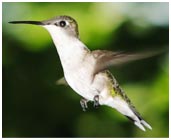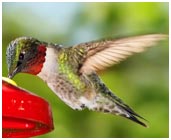Humming birds are tiny birds with amazing level of energy and power. Check out interesting facts and information on hummingbirds.
Humming Birds Facts
Humming birds are a fascinating creation of nature. This bird is the tiniest bird on the planet. Hardly measuring more than your palm size, these tiny birds are a storehouse of immense power and energy. It is a member of the Trochilidae family. Humming birds get their name from the fact that when they beat their wings, it produces a humming sound, like that of bees. This tiny little bird can fly great distances without stopping even once due to immense power. It feeds mainly on nectar from flowers and also tiny insects. A hummingbird can survive for an average of 10 years in captivity, but in wild it survives for 3-5 years. Hummingbirds do not have the ability to smell, but these birds can hear more clearly than human beings. Another fascinating fact is that the metabolism of these birds is about 100 times faster than elephants. Given below are some interesting facts about humming birds. 

Fast Facts
Scientific Name: Trochilidae
Kingdom: Animalia
Phylum: Chordata
Subphylum: Vertebrata
Class: Aves
Order: Apodidae
Family: Trochilidae
Genus: N/A
Species: N/A
Origin: South America
Diet: Nectar from flowers such as butterfly bush, lantana, mimosa and red buck-eye.
Height/Length: 7.5 - 13 cm
Weight: 2 - 23 g
Natural Habitat: Forest areas, meadows and grasslands.
Lifespan: 3 - 5 years
Type: 300 species
Status: Endangered
Age of Maturity (females): 1 year
Age of Maturity (males): 1 year
Gestation Period: 14 - 23
Number of Offspring: 1 - 2
Interesting and Amazing Information on Hummingbirds
- Humming birds are found in North and South America. In the north, they can be found as far as Alaska and in the south, they can be spotted as far as southern Chile.
- The smallest hummingbird is the Bee Hummingbird. It is so small, it weighs a bit less than 2 grams and measures around 2 inches! The biggest humming bird is called the Giant hummingbird and is around 8 inches in length and weighs around 20 grams.
- Humming birds essentially feed on flower nectar along with small insects. They may also feed on pollen occasionally, but their main diet is nectar.
- Humming birds help in pollination as they carry pollen on their backs just like bees when they go from one flower to another in search of nectar. One humming bird visits around 1000-2000 flowers in a single day!
- Humming birds, on an average, beat their wings 80 times per second. However, in some species, it has been recorded that these creatures can beat their wings 200 times per second.
- An amazing fact about the humming bird is that it can fly up, down, forward, backward and even upside down. A humming bird can rotate its wings from its shoulder blades, which enables it to hover and fly in different positions.
- When active, a humming bird breathes around 300-500 times every minute. The heart of a humming bird makes up for around 20% of the body volume. The heartbeat ranges from 30-1500 per minute, depending on the specie and the activity.
- The brain of a hummingbird constitutes 4.2% of its total body weight, which is the largest when compared to all the birds in the bird kingdom. These birds are so intelligent that they have the ability to remember every flower.
- The vision of these tiny birds is so spectacular that they can see places much farther than any human being. Moreover, these birds can also see ultraviolet light.
- Hummingbirds use their tongues to drink nectar from the flowers. There are small hairs on the tip of a hummingbird’s tongue and their tongues are shaped like a ‘w’.
- The bird’s flight muscles constitutes 30% of its body weight.
- A hummingbird’s beak is large when compared to its body. The bottom beak of this bird is quite flexible and the hummingbird’s top beak is larger than its bottom beak.
- One hummingbird has around 940 feathers in its body.
- A female hummingbird can lay one or two eggs and these eggs are as small as peas. These eggs take almost 2 to 3 weeks for it to hatch. The male hummingbirds do not stay with its mate or care for its newborns.
- The body temperature of a hummingbird is approximately 41.6°C.


See also
More from iloveindia.com
- Home Remedies | Ayurveda | Vastu | Yoga | Feng Shui | Tattoos | Fitness | Garden | Nutrition | Parenting | Bikes | Cars | Baby Care | Indian Weddings | Festivals | Party ideas | Horoscope 2015 | Pets | Finance | Figures of Speech | Hotels in India : Delhi | Hyderabad | Chennai | Mumbai | Kolkata | Bangalore | Ahmedabad | Jaipur
- Contact Us Careers Disclaimer Privacy Policy Advertise With Us Lifestyle Sitemap Copyright iloveindia.com. All Rights Reserved.




